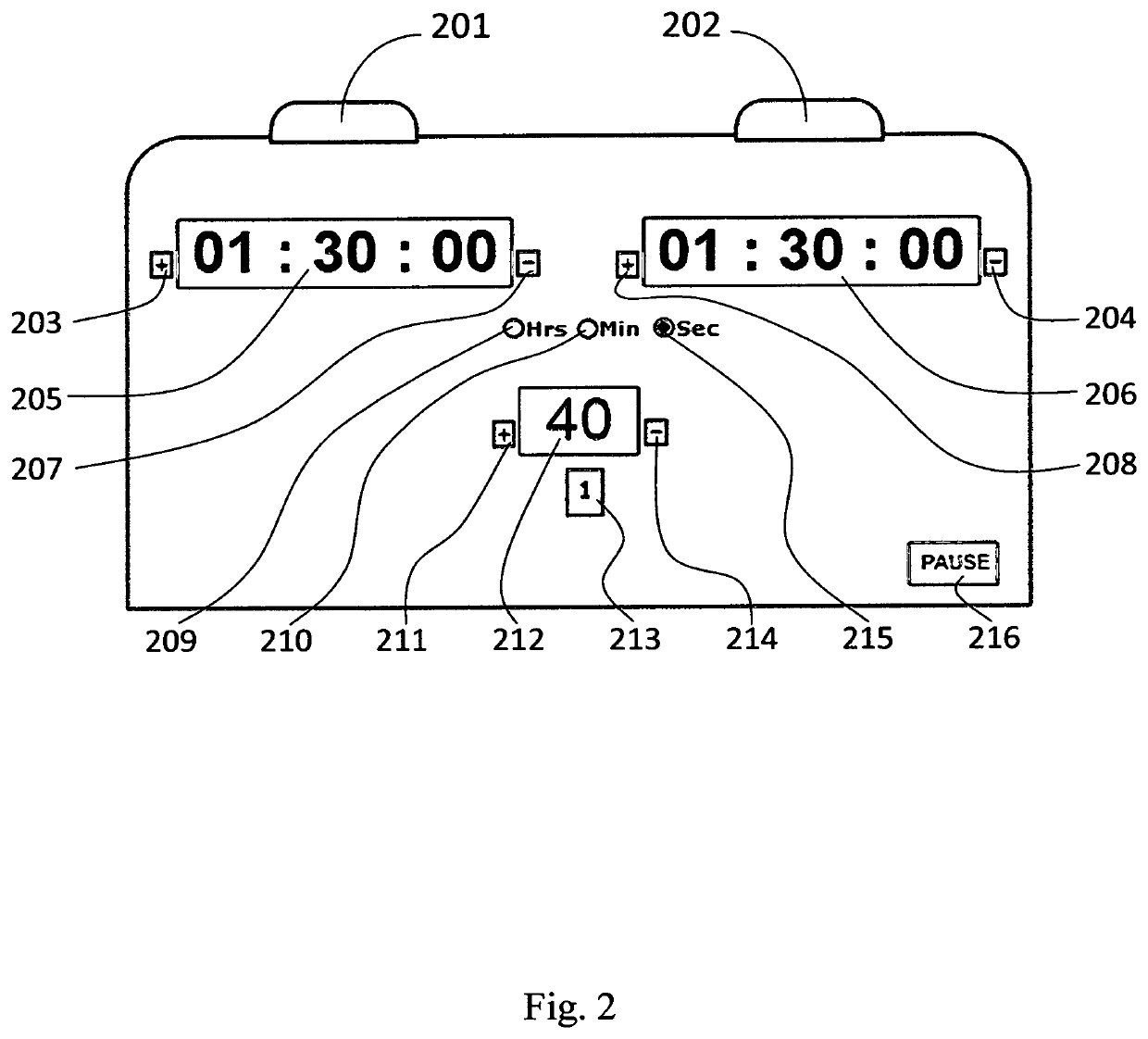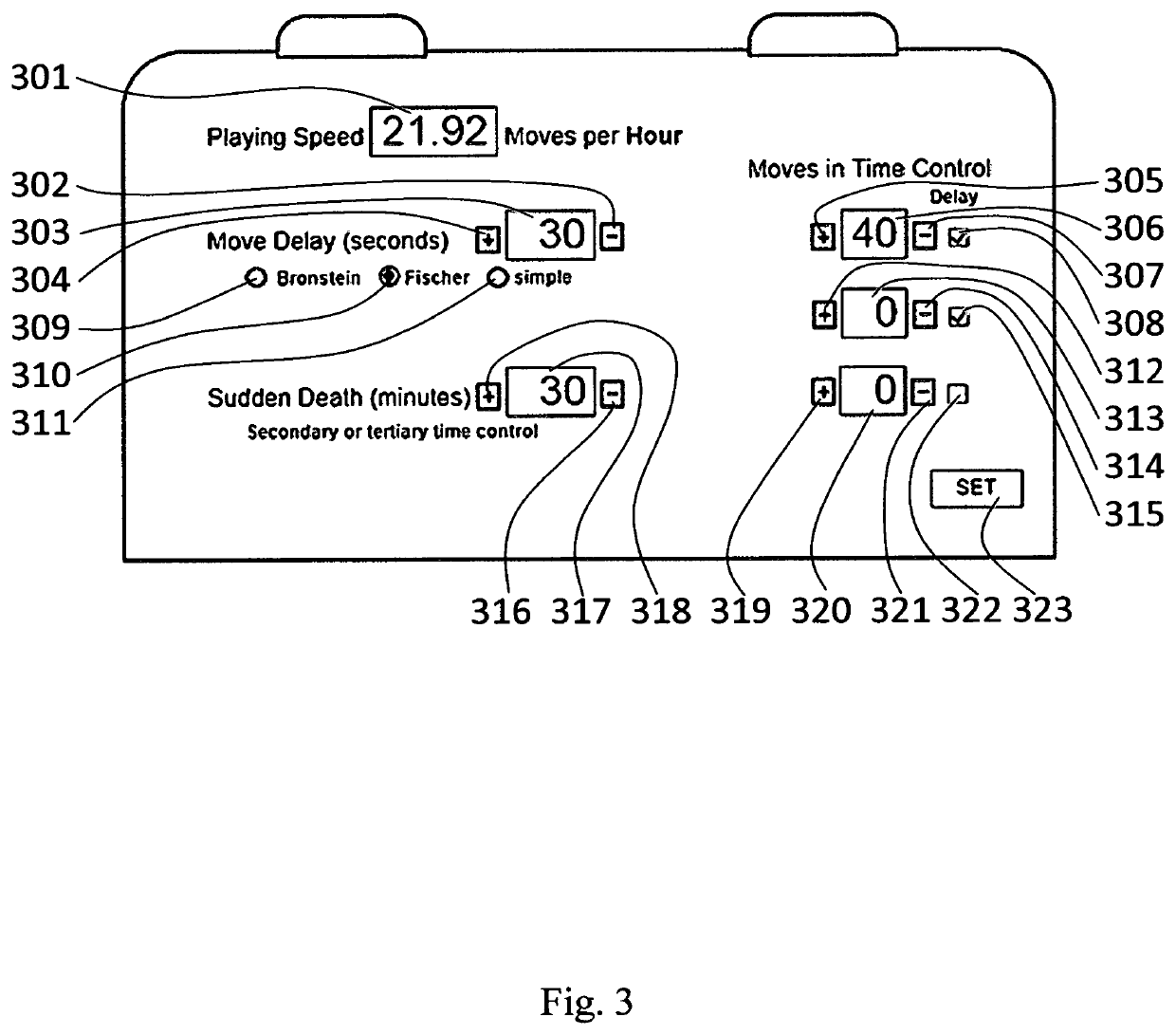Digital chess clock displaying calculated playing speed
a digital clock and playing speed technology, applied in the field of digital chess clocks displaying calculated playing speed, can solve the problems of fischer increment, more difficult to calculate playing speed with precision, neglected concept of general playing speed,
- Summary
- Abstract
- Description
- Claims
- Application Information
AI Technical Summary
Benefits of technology
Problems solved by technology
Method used
Image
Examples
first embodiment
Operation—First Embodiment
[0053]FIG. 4 shows the input process for setting up a specific time limit. It begins by pressing the Set button (323) twice within one second or a comparably short period of time. The double click is a preventive measure against accidental resets in the course of play. Activation of the Set button enables input. It is followed by automatic activation of the Pause button (216), which enables input on the front of the clock. There follows an optional set of manual inputs in which values on the front and back may be adjusted using the increment and decrement buttons associated with each value. The number of moves required for each time control (306, 313, 320) is entered. A zero value indicates a sudden-death time control, which effectively ends the series of time controls. Time controls subsequent to sudden death are zeroed out and ignored for purposes of calculation. The check boxes (308, 315, 322) to the extreme right of each time control are used to indicat...
second embodiment
Operation—Second Embodiment
[0063]FIG. 12 shows the transition from one time control to the next when a move button is pushed with one move remaining in the current time control, as displayed (1102, 1105) on the side completing the move. If there is more than one move remaining or zero moves, processing continues in FIG. 13. As the designations of FIG. 3 apply equally well to the second embodiment, the time control advances from the primary (306) to the secondary (313) or from the secondary to the tertiary (320), or the tertiary control repeats itself indefinitely. The number of moves in the new time control is assigned to the variable M and displayed on the side completing the move (1102, 1105). Processing then proceeds to a consideration of whether or not the new control is checked (315, 322), and the rest of FIG. 12 is identical to FIG. 9.
[0064]FIG. 13 shows the completion of processing for a move other than the final move of a nonterminal time control. Most of the processing is i...
third embodiment
Operation—Third Embodiment
[0066]FIG. 15 shows processing of input prior to start of a game, corresponding to the operations of FIG. 5, but much simplified. If the primary control (306) shows zero moves, indicating sudden death for the entire time limit, the allotted time is taken from input starting time (205), and Sudden Death (317) is set to zero; the secondary (313) and tertiary (320) time controls are set to zero. If the primary control (306) is nonzero and the secondary control (313) is zero, the tertiary control (320) is set to zero. Finally, if all three time controls are nonzero, sudden death does not apply in the time limit, and Sudden Death (317) is set to zero.
[0067]FIG. 16 shows further processing of input. The operations largely correspond to those of FIG. 6, but the error condition that sometimes arises when the primary time control is unchecked cannot occur. After initialization of variables for delay and initial delay, the Time Control Number is set to 1. The number ...
PUM
 Login to View More
Login to View More Abstract
Description
Claims
Application Information
 Login to View More
Login to View More - R&D
- Intellectual Property
- Life Sciences
- Materials
- Tech Scout
- Unparalleled Data Quality
- Higher Quality Content
- 60% Fewer Hallucinations
Browse by: Latest US Patents, China's latest patents, Technical Efficacy Thesaurus, Application Domain, Technology Topic, Popular Technical Reports.
© 2025 PatSnap. All rights reserved.Legal|Privacy policy|Modern Slavery Act Transparency Statement|Sitemap|About US| Contact US: help@patsnap.com



